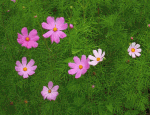
Garden cosmos is a half hardy annual native to Arizona, Mexico and Guatemala to Costa Rica and is a member of the aster family, Asteraceae, that also includes daisy, yarrow, and lettuce. It grows 3-4′ tall and has wispy fern-like leaves with narrow linear pinnate segments. The 2-3″ wide cup-shaped flowerheads are composed of 8 ray flowers in shades of rose-pink to lilac surrounding a center of yellow disc flowers. Cultivars with white or bicolor ray flowers are also available. The flowerheads attract butterflies including Monarchs, are excellent cut flowers, and press well. Plants are easily grown from seed and in warm climates can be planted in both spring and mid summer for a super long bloom season. They look especially well in the back of the border where they can gain some support from sturdier plants. The genus name, Cosmos, is from the Greek word kosmos, meaning beautiful. The specific epithet, bipinnatus, comes from the Latin words bis meaning twice and pinna meaning feather, and refers to the divided appearance of the leaves.
Type: Half hardy annual (perennial in zone 9-10).
Bloom: Red, purple, pink, white and rose flowerheads, 2-3” across, on thin stems from summer to through fall.
Size: 1-7’ H x 3’ W (depending on variety and soil conditions).
Light: Full sun.
Soil: Lean to average, medium moist, well drained; overly fertile soil can result in large plants with few flowers.
Care: Deadhead to encourage rebloom; if plants look “tired” sow seeds in place, pressing the seeds into the soil. Water during times of drought.
Pests and Diseases: None of significance.
Propagation: Seed; may self-seed.
Companion plants: Spider flower (Cleome hassleriana), zinnia, gomphrena, aster, flowering tobacco.
Outstanding Selections:
-
- Sonata series such as ‘Sonata White’ ( 1 ½’-2 ½ ‘ tall, well branched and very floriferous)
-
- Sensation series ( rose, crimson, or white flowers)
-
- Versailles series (3-3.5′ tall; especially good as a cut flower)
-
- ‘Seashell’ (fluted petals)
- ‘Daydream’ (bicolor with pink eye on a white background)
